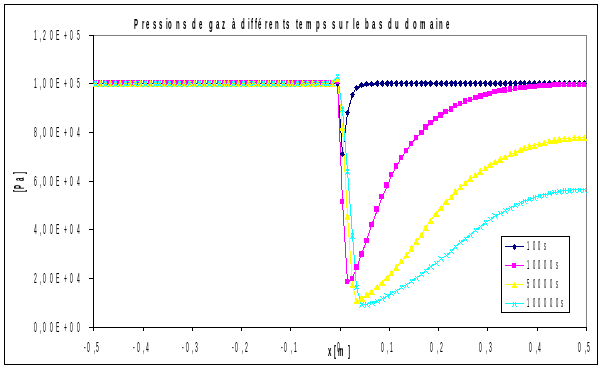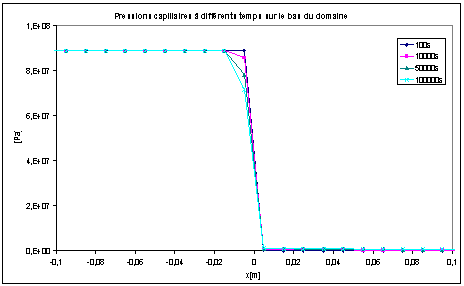4. C modeling#
4.1. Characteristics of C modeling#
D_ PLAN_HH2SUDA modeling. This modeling corresponds to the Volume Finite Decentralized Edge diagram. Coupling LIQU_AD_GAZ. A mesh consisting of 100 QUAD8 elements is used.
We are immiscible and we use an infinite Henry coefficient of \({10}^{20}{\mathrm{Pa.mol}}^{-1}\mathrm{.}{m}^{3}\),
Discretization in time:
\(\mathrm{1000s}\) in 20 steps of time
\(10000s\) in 20 steps of time
1 month in 20 steps of time
2 months in 20 steps of time
6 months in 40 steps of time
1 year in 50 steps of time
10 years in 50 steps of time
50 years in 50 steps of time
100 years in 50 steps of time
500 years in 50 steps of time
1000 years in 50 steps of time
5000 years in 50 steps of time
10,000 years in 50 steps of time
100,000 years in 50 steps of time
1,000,000 years in 50 steps of time
4.2. Results#
The figures below show the gas pressure profiles and capillary pressures along the bi-material at different times:


The results are as expected. It should be noted that compared to finite element diagrams, the gas peak at the interface is here almost imperceptible. This is what was expected from decentralized finite volume schemes. So the results are consistent.
4.3. Tested values#
This test case has no reference value, so we make it a case of non-regression.
Tests are carried out on two values:
Points \((x,y)\) |
Time ( \(s\) ) |
\(\mathit{PRE1}\) Aster |
\(\mathit{PRE2}\) Aster |
Relative error allowed |
\((\mathrm{-}\mathrm{0,005}\mathrm{,0})\) \(\mathit{N105}\) |
\(100\) |
\(8.89{10}^{7}\) |
\(19\) |
\(1\text{\%}\) |
\(100000\) |
\(7.175{10}^{7}\) |
\(2952\) |
\(1\text{\%}\) |
|
\((\mathrm{0,035}\mathrm{,0}\mathrm{,005})\) \(\mathit{NQ54}\) |
\(100\) |
\(10160\) |
\(-1745\) |
\(1\text{\%}\) |
\(100000\) |
\(8.532{10}^{5}\) |
\(-83702\) |
\(1\text{\%}\) |